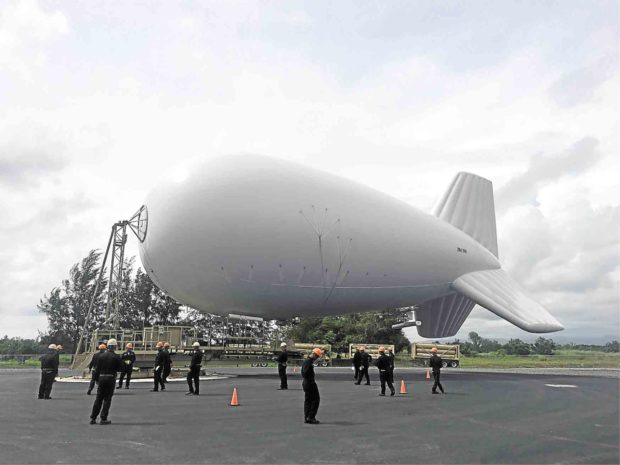
The Tethered Aerostat Radar System, deployed in San Antonio town in Zambales province, is expected to improve the Philippine Navy’s monitoring of the country’s waters. ALLAN MACATUNO
SAN ANTONIO, ZAMBALES—The Philippine Navy on Tuesday acquired a state-of-the-art surveillance system that would help it guard against threats to fishermen and bar criminal activities at sea.
It received a 28M Class Tethered Aerostat Radar System (TARS) from the US government in a turnover ceremony at the Naval Education and Training Command (NETC) here on Tuesday.
US Embassy deputy chief of mission to the Philippines, Michael Klecheski, handed over the TARS to Vice Admiral Ronald Joseph Mercado, Navy flag officer in command.
“The aerostat will provide the Navy with increased awareness of potential threat at sea, such as vessels entering the Philippine sovereign waters and economics,” Klecheski said during the ceremony.
He said TARS “will even disrupt the flow of extremists who attempt to enter the Philippines via its waterways.”
“The aerostat is a truly versatile capability with applications across the maritime domain and even in the fight against terrorists,” he said.
TARS is a self-sustained, rapidly deployable, unmanned lighter-than-air platform that enables the Navy to have maritime surveillance spanning 90 nautical miles from this town, Mercado said.
Its aerostat component is a large fabric envelope filled with helium that can rise up to an altitude of 1,524 meters (5,000 feet) while anchored to the ground by a single cable.
As the largest Navy property with a flat terrain, NETC was chosen to be the staging point because it fits the minimum space requirement for launching the aerostat, Mercado said.
This acquisition enhances the Navy’s maritime intelligence surveillance reconnaissance operations by detecting maritime traffic within the country’s coastal waters using sensors.
The radar system can also be used for humanitarian assistance and disaster response operations. It includes a weather station that provides telemetry data to the ground station for the monitoring of temperature and wind speed. —ALLAN MACATUNO